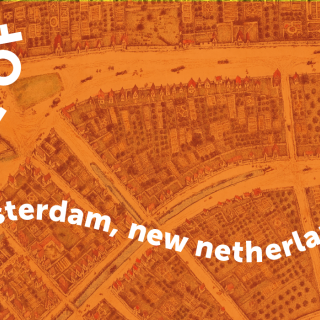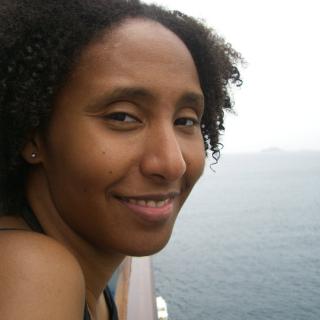Professor Jeroen Dewulf

Jeroen Dewulf is Queen Beatrix Professor in Dutch Studies at the University of California, Berkeley. At Berkeley, he developed a new course on the Dutch history of New York that in 2012 was awarded the American Cultures Innovation in Teaching Award. In his academic research on the Dutch colony, Dewulf has paid special attention to New Netherland's African population, most notably in his book The Pinkster King and the King of Kongo: The Forgotten History of America’s Dutch-Owned Slaves (2017) and articles such as “Iberian Linguistic Elements among the Black Population in New Netherland (1614–1664),” Journal of Pidgin and Creole Languages 34, no. 1 (2019): 49–82; “'A Strong Barbaric Accent': America’s Dutch-Speaking Black Community from Seventeenth-Century New Netherland to Nineteenth-Century New York and New Jersey,” American Speech: A Quarterly of Linguistic Usage, Vol. 90, Nr. 2 (May 2015): 131-153; “Emulating a Portuguese Model: The Slave Policy of the West India Company and the Dutch Reformed Church in Dutch Brazil (1630–1654) and New Netherland (1614–1664) in Comparative Perspective,” Journal of Early American History 4 (2014): 3–36; and “Pinkster: An Atlantic Creole Festival in a Dutch-American Context,” Journal of American Folklore 126, no. 501 (2013): 245–71. His latest book, entitled Afro-Atlantic Catholics: America’s First Black Christians, is forthcoming with Notre Dame University Press.
Jeroen Dewulf will like to express deep thanks and gratitude to Jaap Jacobs and Julie van den Hout for reviewing earlier draft answers to these questions
1) What is colonialism?
The term colonialism is derived from the Latin colonus, meaning “farmer.” In the Roman Empire, plots of conquered land as well as servi (enslaved war captives) were granted to soldiers as a form of compensation for their war efforts. These former soldiers then became farm-owners and contributed to the spreading of Roman culture in the conquered territories. The name of the German city of Cologne, once founded by the Romans, recalls this system.
The Spanish implemented a similar practice following the sixteenth-century conquest of the Americas. Large numbers of people moved from Spain to the conquered lands, where they started a new life as permanent settlers and disseminated aspects of Spanish culture such as language and religion throughout the region.
Over time, the term “colonialism” was used more broadly to refer to the domination of foreign lands, the subjugation of the local population, and the economic exploitation of resources. Similar to the term “imperialism,” it implies that the conquering nation imposes its policy onto the foreign land and its people. Yet, colonialism tends to have a more specific meaning, associated with the transfer of people from the conquering nation as permanent settlers to the conquered land.
Today, the term is mainly associated with the European conquering of overseas territories and peoples, although it has also been used in reference to similar policies by other nations, such as the Turkish Ottoman Empire, China, and Japan.
2) How did Dutch colonialism develop and in what ways did it differ from that of other European nations?
European colonialism started with Spain and Portugal, who, with the blessing of the Pope, divided the world among themselves in the 1495 Treaty of Tordesillas. Whereas Spain controlled the Americas, Portugal was given control over the trade in products from Africa and Asia, which included the highly lucrative spice trade. The Dutch were the first to break the monopoly of these two Iberian nations.
This Dutch decision to challenge the Iberian monopoly was a direct consequence of the sixteenth-century Dutch Revolt against the Iberian King Philip II. Philip ruled over a gigantic empire that not only included Spain, Portugal, and all the Iberian colonies, but also parts of Italy and the Seventeen Provinces of the Netherlands. People in the Netherlands resented the oppressive governance of Philip's regime and started a rebellion that, ultimately, led to the independence of the Republic of the Seven United Netherlands, also called the Dutch Republic. Since their revolt had made them enemies of Spain and Portugal, Dutch merchants were denied access to Iberian ports and were, thus, no longer able to trade in products from overseas markets that Spain and Portugal controlled. Shortly after gaining independence, the Dutch Republic therefore developed into the main competitor of Spain and Portugal.
In 1602, the Dutch founded the East India Company, which successfully broke the monopoly of Portugal as the sole European nation with access to the Asian market. The economic success of the East India Company in Asia led to the establishment, in 1621, of the Dutch West India Company, which focused on Atlantic territories in Africa and the Americas.
Unlike Spain and Portugal, whose colonial expansion was a national endeavor, the Dutch overseas expansion was organized by private companies with shareholders. While the Iberian nations had justified their colonial policies as an endeavor to spread Christianity, the Dutch emphasized the notion of free trade and argued that if international trade were to become free, all nations would benefit from it. The Dutch showed much less interest than the Spanish or Portuguese in the spreading of their own religion and language in territories under their control. They prioritized profitmaking and did not hesitate to betray their own rhetoric about the benefits of free trade when opportunities arose to obtain a monopoly. This included the trade in human beings, a practice to which the Dutch applied a double standard. While slavery was prohibited in their homeland, it was considered legitimate in overseas territories.
Considering that the Dutch Republic was one of the wealthiest nations in seventeenth-century Europe, the board of directors of both companies knew that it would be difficult to populate large overseas territories with Dutch settlers. Nevertheless, they did conquer some foreign lands and colonized them by exploiting natural resources and sending colonists and enslaved people. This policy was accompanied by the oppression, displacement, or massacring of the Indigenous populations.
3) Why did the Dutch establish a colony in North America?
The history of the Dutch colony in North America started with the English explorer Henry Hudson, who had been hired by the Dutch East India Company in 1609 to explore a new sailing route to Asia. Upon realizing that the ice in the seas north of Russia impeded a northeast passage to Asia, Hudson ignored orders and sailed to the west. In his (failed) attempt to reach Asia by sailing through North America, Hudson sailed up the river that today bears his name.
Since no other European nation had yet developed a settlement in that part of the American east coast—the Spanish did not go north of Florida, while the French focused on territories along the Saint Lawrence River in today’s Canada and the English on Virginia—the Dutch decided to further explore the region where Hudson had landed. They had learned from the English captain that the local Indigenous population was eager to develop a trading relationship with the Dutch. One product, in particular, attracted the attention of the Dutch: beaver pelts. These were used in Europe for the production of luxury textiles, mainly hats. Since beavers had become rare in Europe and prices of pelts were soaring, the area soon attracted Dutch fur traders. In order to put an end to competition among these merchants, the Dutch authorities established the New Netherland Company in 1614. This chartered company regulated prices and set standards to secure peaceful trade with the Indigenous populations.
4) How did Dutch colonists rely on the Indigenous nations to advance their colonial project of New Netherland?
The establishment of New France in the sixteenth century had dramatically changed Indigenous power relations in North America. Those who traded with the French got access to European products and weaponry, which strengthened their position in relation to rival nations. The power dynamics among Indigenous nations was further complicated when, in the early seventeenth century, the English and later also the Dutch arrived on the American east coast.
In 1614, the Dutch built their first trading post in North America, known as Fort Nassau. They did so on Castle Island, a small island in the North River (today’s Hudson River) that is now part of the city of Albany. The fortress was mainly used as a warehouse for Dutch fur traders.
This trading post was built in territory claimed by the Mahican nation. The Mahicans spoke an Algonquian language that was similar to that of other nations (Lenape, Munsee, Raritan and others) in the region, whom the Dutch called River Indians. Since the Dutch offered to trade products that the Mahicans were unable to make themselves, such as iron cooking pots, knives, and guns, these Indigenous nations allowed the Dutch to develop a network of small trading posts.
Aware of their dependency on the Indigenous people to obtain beaver pelts, the Dutch were cautious to preserve friendly relations. The West India Company stipulated that land could not be conquered in a violent manner but had to be obtained on the basis of negotiations that required compensation in the form of trading goods. The Dutch soon experienced, however, that the Native populations had a different concept of land ownership. While the Dutch assumed that they had now become the landowners, the Indigenous people, migrating in seasonal patterns, continued to use the land that, in their view, had only been shared with the European newcomers.
An additional challenge for the Dutch was the growing rivalry between the Mahicans and the Mohawks. The Mohawks were one of the five (later six) nations of the powerful Haudenosaunee Confederacy. The Mohawks had come under pressure following the expansion of New France and indigenous allies of the French, who attempted to take over their hunting grounds. The Mohawks, therefore, hoped to strengthen their position by trading with the Dutch. In the increasingly tense relationship between Mahicans and Mohawks, it became difficult for the Dutch to maintain a neutral position. Over time, the Mohawks succeeded in pushing the Mahicans out of the region and virtually obtained a trading monopoly in beaver pelts with the Dutch.
5) What is the West India Company and what was its role in New Netherland?
Founded in 1621, the Dutch West India Company (WIC) was modeled upon the economically successful East India Company. While the latter focused on the Indian Ocean, the former intended to break the Portuguese and Spanish trading monopoly in the Atlantic realm. This first occurred through privateering, a form of piracy whereby Dutch vessels cruised the Atlantic in search of Iberian ships to conquer. The capture, in 1628, of a Spanish fleet carrying silver to Europe enabled the company to switch from privateering to conquest. It sold the silver and other treasure obtained in the attack and used the revenue to conquer a number of Caribbean islands from the Spanish. The WIC also launched an attack on the Portuguese colony of Brazil. In the 1630s, the company managed to occupy the northeastern part of Brazil, where there were large sugarcane plantations. Since most of the enslaved Africans who worked on these plantations had taken advantage of the attack in order to escape, the Dutch also conquered several Portuguese slave trading posts in Africa from which people were sent as workforce to Brazil.
The company never succeeded in making its Brazilian colony economically successful and, in 1654, it was recaptured by the Portuguese. In order to avoid bankruptcy after the loss of Brazil, the company decided to focus on the lucrative slave trading business. From its remaining posts in Africa, it began to ship thousands of enslaved people to the Caribbean Island of Curaçao, where they were sold to merchants of different nations.
Beginning in 1621, the West India Company was also responsible for the government of New Netherland. After some hesitation, the company’s board of directors abandoned a policy that focused exclusively on trade and decided to develop New Netherland into a colony to strengthen Dutch claims to the territory. In 1624, the first group of settlers arrived, mainly French-speaking Protestants who had immigrated to the Dutch Republic and felt attracted by the idea of developing a colony in North America. One year later, the first child of European descent was born in New Netherland, named Sarah Rapalje.
6) What was the role of a director in New Netherland, what areas of responsibility did directors hold, and how did this role evolve over time?
The decision by the West India Company to build a colony in New Netherland required the development of an administration and the sending of an administrative director. The director was charged with ensuring that Company decisions were implemented in the colony, and he stimulated trade, levied taxes, and took care of day-to-day management. He was also in charge of the armed forces.
Initially, the capital of the colony was to be on a small island called by the Dutch Noteneiland (Walnut Island, today’s Governors Island), but in 1625, the company decided to use the southern tip of Manhattan instead. There, New Amsterdam was built as, the administrative and political center of the colony. Director Peter Minuit is credited with the decision to relocate the capital, after negotiating with members of the Indigenous population for the “purchase” of Manhattan. Like many of the earliest settlers in New Netherland, Minuit was a French-speaking Protestant. Although he was successful in building the foundations of the colony, a dispute developed among the colonists that led to his resignation in 1631 and the appointment of Wouter van Twiller as his successor.
In 1638, a new director, Willem Kieft, arrived in the colony. During his tenure, New Netherland initially experienced a phase of economic growth following the company’s decision to abandon its trading monopoly and open the colony to investors. Soon, however, Kieft faced a number of challenges. The borderlands of the colony were disputed by aggressive English colonists as well as by newly arrived Swedish colonists. Most importantly, the settlers criticized Kieft for his lack of diplomacy in escalating a dispute with Indigenous nations into an open war. This created stubborn opposition from the local elites in New Netherland, who advocated for more political autonomy in internal affairs, a struggle that ultimately led to his dismissal in 1647.
The colony’s last director was Petrus Stuyvesant, who came over from Curaçao, where he had lost a leg in a battle against the Spanish. During his tenure, the company lost Dutch Brazil and many of its colonists moved to New Netherland. This population increase was accompanied by new investments that boosted the local economy and strengthened its military capacity. Stuyvesant used his military power to force the Swedish colony to surrender, suppressed a subsequent uprising of Indigenous nations, and contained the English threat to the north of the colony. Although his law-and-order policy brought stability back to the colony, his rigidness in religious and moral affairs caused controversy. As a strict Calvinist, Stuyvesant applied heavy fines onto those who disrespected the Sunday rest and attempted to exclude and curb the rights of religious minorities such as Quakers and Jews. He also faced opposition from a coalition of disgruntled colonists led by Adriaen van der Donck, who demanded more political autonomy. In 1664, an English fleet and the arrival of 1,500 New England militiamen forced Stuyvesant to surrender the colony.
7) What was Kieft’s War and how did it affect the future interactions and relations between the Dutch and the Indigenous nations?
Kieft’s War (1643-45) refers to a military conflict between the Dutch in New Netherland and the surrounding Indigenous nations that occurred during Kieft’s tenure as company director. The roots of the conflict were multiple. In the early years of Kieft’s tenure, the number of European settlers had grown considerably, requiring more land. Moreover, beavers had become overhunted and had to be searched for in increasingly distant areas. As a result, the Dutch no longer perceived the Indigenous peoples who lived near New Netherland, as useful trading partners. In addition, the Natives of the region had a different understanding of land ownership than the Dutch and frequently returned to the land the Dutch thought they had purchased from them. The resulting tensions were exacerbated by the intensification of Mohawk attacks on Algonquian Natives, who frequently fled to land purchased by the Dutch.
Pressured by disgruntled settlers, Kieft informed the Indigenous nations surrounding New Netherland that, henceforth, they would have to pay tribute for entering Dutch territory. Their refusal to do so led to skirmishes in which a European settler got killed. Although the Council of Twelve Men, an advisory board, had advised against retaliation, Kieft used this tragic incident to impose his authority and allowed an attack that resulted in several dozen Native casualties. Upset by the bloodshed, the Algonquian nations formed an alliance and retaliated. Dutch military forces were soon overwhelmed when an army of 1,500 Native warriors attacked the colony. All over the colony, farms were burned down and colonists were either killed or fled to the capital New Amsterdam. Many of them subsequently abandoned the colony altogether and returned to Europe.
Kieft ignored pleas by the Council to seek a diplomatic solution to the conflict. Rather, he dissolved the Council and hired Captain John Underhill, an English soldier experienced in military tactics against Native warriors, to retaliate. The result was continuous bloodshed on both sides that only ended after Kieft finally gave in and started negotiations. The war ended in 1645 with a peace treaty that brought back stability to the colony. The damage caused by the war made Kieft’s position untenable; the company considered him accountable for the losses and decided to call him back to Europe. The ship that was to bring him home sank on its way to the Netherlands and Kieft drowned.
8) How did Dutch culture and religion shape the creation of New Netherland and life in the colony?
In the seventeenth century, the Dutch Republic was one of the wealthiest countries in Europe. Dutch society was also characterized by a commitment to freedom of conscience, which implied that people were not persecuted for their religious, political, or philosophical beliefs. Under these circumstances, the West India Company struggled to find Dutch people willing to emigrate to its American colony. As a result, a large percentage of the population in New Netherland consisted of people with roots in other parts of Europe, such as Flanders, Wallonia, Germany, England, France, and Scandinavia. For this reason, several European languages were spoken in the colony. Also, in terms of religion, New Netherland was a remarkably diverse colony. While the Dutch Reformed Church, the company’s official religion, had a privileged position, the European community in New Netherland also eventually included large numbers of Lutherans, Anglicans, and Quakers, as well as small groups of Catholics, Jews, and other religious minorities.
Over time, intermarriage and a desire to provide better career opportunities for one’s children stimulated a process of assimilation to Dutch standards. Although this process came to a halt following the English conquest of New Netherland in 1664, English identity and the English way of life did not immediately impose themselves. Especially in rural parts, many people held on to the Dutch language and the Dutch Reformed Church. Dutch was also spoken by African Americans in the region. It is estimated that, by the mid-eighteenth century, about a third of New York’s Black population spoke Dutch and many of them did so as their native language. Among them was the famous civil rights activist Sojourner Truth, who was born in 1797 in a village near Kingston where most of the people still spoke Dutch. Today, several words and expressions of Dutch origin are commonly used in American English, such as “cookie,” “coleslaw,” “boss,” and “Santa Claus.”
9) What do we know about the enslaved African population in New Netherland?
Although they originated from a country where slavery was prohibited, the Dutch seem to have had few concerns about the morality of this practice in their American colony. The earliest enslaved Africans arrived in New Netherland in the 1620s. They most likely had been on a Portuguese or Spanish ship that was captured by Dutch privateers. While most enslaved people were taken to the Dutch colony in Brazil, small numbers also arrived in New Netherland. After the Portuguese launched their military campaign to reconquer the Brazilian colony, more enslaved people were taken to New Amsterdam. Following the fall of Dutch Brazil in 1654, Curaçao became the center of Dutch slave-trading operations. From there, additional shipments of enslaved Africans were taken to New Netherland. Some four hundred people who arrived in 1664 on a ship from Curaçao virtually doubled the entire enslaved population. Slavery was primarily an urban institution in New Netherland. It is estimated that between ten and seventeen percent of the population in the colony’s capital of New Amsterdam had African roots.
The abundance of names ending in “Congo” and “Angola” indicates that the overwhelming majority of Africans in New Netherland were of West-Central African origin and probably spoke either Kikongo or Kimbundu as their native language. Their typically Portuguese baptismal names such as Francisco, Manuel, Isabel, and Maria as well as surnames such as Britto, Premero, and Portogys indicate that many of them had gone―with various degrees of exposure―through a process of Iberian, Catholic acculturation before arriving in the Dutch colony. In fact, several members of the colony’s Black community were able to communicate in Portuguese.
In the early decades of the colony, the West India Company owned most of the enslaved people. They enjoyed a limited number of privileges, such as the right to marry, to own cattle, to farm their own gardens, to sell their products on the market, and even to sue Europeans in court. The company provided housing and medical care and occasionally paid them for extra work. The enslaved people were typically employed for hard and dirty work, such as building roads, clearing the streets of animal carcasses, flogging criminals, and executing convicts. By the 1650s, private ownership increased. Upon their arrival, enslaved people were sold at public auctions where anyone could buy them with cash, beaver pelts, or other provisions. Some colonists also bought enslaved people as an investment and leased them to others.
Africans reacted in different ways to their enslavement. While some tried to liberate themselves from the shackles of slavery by running away, others hoped to obtain their freedom in exchange for assisting the Dutch authorities in dangerous operations, such as hunting down runaways and participating in military operations against the Indigenous nations. Many of them also used religion to establish common ties with the Dutch community; they married in the Dutch Reformed Church and had their children baptized there. Those who, in this way, built trustful relationships with the Dutch later capitalized on that trust to demand concessions and ultimately manumission for themselves and their families.
By the 1660s, New Netherland counted at least seventy-five free Black residents, several of whom were landowners. Free Black landowners and poor, white New Netherlanders lived side by side and occasionally cooperated to defend common interests, which fostered biracial relationships.
10) Why did the English conquer New Netherland from the Dutch and why did the Dutch surrender without a fight?
The Dutch decision to build a colony in North America had from the very beginning been opposed by the English, who claimed the entire east coast for themselves. From an English perspective, the Dutch colony was illegal. Moreover, the English authorities had less difficulty convincing people to move to America. Soon, conflicts erupted when both at the northern and the southern border of New Netherland, English settlers occupied land claimed by the Dutch.
This dispute over New Netherland was but one element in a larger conflict that was developing between England and the Dutch Republic. Following the decline of Spain and Portugal, both nations were eager to dominate the European market for overseas products such as spices, sugar, and tobacco. Ultimately, these tensions led to a military conflict. Although New Netherland was not attacked during the First Anglo-Dutch War (1652-54), the English King Charles II sent a fleet to the Dutch colony in 1664 and demanded its surrender. The military strength of the English in combination with a lack of support among the local population to risk a fight made Director Stuyvesant decide to surrender without a fight. Soon after, however, Dutch troops attacked and occupied the region of Suriname in the Caribbean. In 1667, the Peace of Breda that put an end to the Second Anglo-Dutch War (1665-67) determined that the English were allowed to keep New Netherland, while the Dutch Republic maintained Suriname. The Dutch briefly retook New Netherland in 1673, but relinquished the colony to the English the following year at the conclusion of the Third Anglo-Dutch War.
Since the terms of surrender had been relatively mild, the vast majority of residents in New Netherland decided to stay in what had now become an English colony. Even Stuyvesant himself lived the final years of his life on his bouwerij (farm) and was buried in the church of Saint Mark’s-in-the-Bowery. While the Dutch population in Manhattan assimilated relatively quickly to English standards, rural parts of New York and New Jersey maintained a Dutch character until the American Revolution.





